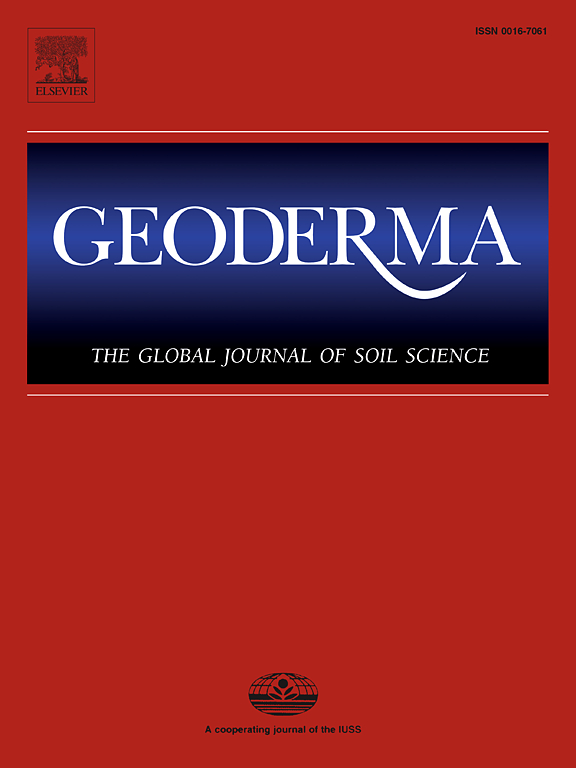Nitrogen addition promotes the coupling of deep soil carbon and nitrogen under different vegetation restoration types in the Chinese Loess Plateau
IF 5.6
1区 农林科学
Q1 SOIL SCIENCE
引用次数: 0
Abstract
Carbon-nitrogen coupling is important to maintain various functions in forest ecosystems and is thus, an important indicator of forest ecosystem health. However, the magnitude of this indicator’s importance to environmental changes remains virtually unknown, especially for deep soils across vegetation types. In this study, four representative sites, namely Pinus tabulaeformis forest, Robinia pseudoacacia forest, Pinus tabulaeformis x Robinia pseudoacacia mixed forest, and Populus davidiana x Quercus wutaishanica natural secondary forest, were selected as representatives of typical artificial and natural forests. A one-year N addition experiment was conducted to analyze C-N coupling conditions of different vegetation restoration types, and soil properties in the 0 – 100 cm layer, litter traits, and rainfall distribution characteristics were measured and compared during the growing season. (1) Soil C and N in artificial forests decoupled with increasing soil depth, while soil C and N were highly coupled among all soil depths in natural forest. (2) N addition had a greater effect on deep soil nutrient accumulation compared to topsoil. (3) N addition decreases the rates of change of deep soil N, which, in turn, enhanced the C and N coupling. (4) Moreover, further analyses with a structural equation model showed that summer precipitation is the key regulator of soil C:N ratio in topsoil. Soil pH, litter C:N ratio, and N deposition were primarily responsible for controlling deep soil C and N coupling. These results indicate that N addition and vegetation restoration types affect soil C and N coupling and should be taken into consideration when assessing deep soil C and N biogeochemical cycles. The importance of deep soil should be considered as much as possible during afforestation on the Loess Plateau. Afforestation should be conducted in a way of natural restoration. This study provides novel insights into the regulatory mechanisms of C and N biogeochemistry and the afforestation patterns of vegetation restoration in arid and semi-arid regions.

氮素添加促进了黄土高原不同植被恢复类型下深层土壤碳氮耦合
碳氮耦合对维持森林生态系统的各项功能具有重要意义,是森林生态系统健康状况的重要指标。然而,这一指标对环境变化的重要性的程度几乎仍然未知,特别是对于各种植被类型的深层土壤。本研究选取油松林、刺槐林、油松与刺槐混交林、大杨树与五台山栎天然次生林4个代表性样地作为典型人工林和天然林的代表。通过为期1年的N添加试验,分析不同植被恢复类型的C-N耦合条件,测量并比较生长季节0 ~ 100 cm层土壤性质、凋落物特征和降雨分布特征。(1)人工林土壤C、N随土层深度的增加而不耦合,天然林土壤C、N在各土层深度之间高度耦合。(2)氮素添加对深层土壤养分积累的影响大于表层土壤。(3)氮素添加降低了深层土壤氮的变化速率,从而增强了碳氮耦合。(4)进一步的结构方程模型分析表明,夏季降水是表层土壤C:N比的关键调节因子。土壤pH、凋落物C:N比和N沉降是控制深层土壤C - N耦合的主要因素。这些结果表明,氮添加和植被恢复类型影响土壤C和N耦合,在评价深层土壤C和N生物地球化学循环时应予以考虑。黄土高原造林应充分考虑深层土壤的重要性。植树造林应以自然恢复的方式进行。本研究为干旱半干旱区植被恢复的C、N生物地球化学调控机制和造林模式提供了新的认识。
本文章由计算机程序翻译,如有差异,请以英文原文为准。
求助全文
约1分钟内获得全文
求助全文
来源期刊

Geoderma
农林科学-土壤科学
CiteScore
11.80
自引率
6.60%
发文量
597
审稿时长
58 days
期刊介绍:
Geoderma - the global journal of soil science - welcomes authors, readers and soil research from all parts of the world, encourages worldwide soil studies, and embraces all aspects of soil science and its associated pedagogy. The journal particularly welcomes interdisciplinary work focusing on dynamic soil processes and functions across space and time.
 求助内容:
求助内容: 应助结果提醒方式:
应助结果提醒方式:


